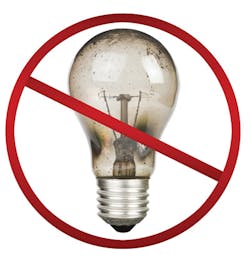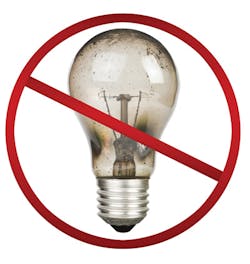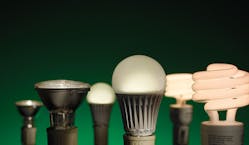The energy savings, long lifetimes, performance, and aesthetics of LEDs can be optimized by combination with advanced intelligent lighting control technologies in both residential and commercial lighting applications, says PEKKA HAKKARAINEN.
In the last few years, LED light sources have gone from being an interesting novelty to a new light source option that can be used for energy savings, long life, and high performance in almost any application. A 15W LED lamp can replace a 75W incandescent lamp, deliver a useful lifetime averaging 25,000 hours, be dimmable, require no warmup time, and offer superb color rendering.
These advantages alone capture our attention and ensure a strong future for LEDs. Paired with smart lighting control technologies that enhance both the energy savings and aesthetic benefits of LEDs, as well as incentives and rebates that often help to offset the initial installation costs, LEDs represent an economically attractive alternative to both commercial and residential end users.
LED revolution and regulations
For most consumers, the phase-out of the traditional incandescent lamp provides the most significant impetus for investing in LEDs (Fig. 1). The Bush-era Energy Independence and Security Act (EISA 2007) dictated a multi-year phase-out of the most commonly used and inefficient light sources. As of January 1, 2014, traditional 60W and 40W incandescent bulbs can no longer be manufactured or imported into the United States. This follows the 100W and 75W bulbs, which were eliminated on January 1 of 2012 and 2013, respectively, as shown in the table.
Halogen bulbs have not been affected by the incandescent phase-out, offer similar light output to incandescent reflector bulbs, and work with standard dimmers, but they do not provide the energy efficiency or long life offered by equivalent LED replacements. Fig. 2 shows a sampling of various bulb options offered in the market.
Screw-in LEDs, with their falling prices and rapid product changes, hold the most promise for changing the way consumers experience lighting and delivering significant lighting energy savings. Beyond homeowners, high-end retail outlets, restaurants, and the hospitality industry are the customers most likely to rely on the familiar light quality and full-range dimming control options offered by incandescent sources. Ultimately, LEDs are the most efficient alternative to incandescent bulbs, and the most likely replacement. However, compatibility between LED lamps, drivers, and controls can be confusing, and when controls and lamps are not properly paired, performance will suffer.
In an effort to minimize consumer confusion, and to make it easier for manufacturers to design lamps and dimming controls that ensure basic compatibility, the National Electrical Manufacturer's Association (NEMA) has published NEMA SSL 7A-2013 – Phase cut dimming for solid state lighting: Basic compatibility.
NEMA SSL 7A-2013 proposes a standard for the recommended interface between the source and the dimming control, including the electric current requirement of the power supply internal to modern digital dimmers. According to NEMA, "All dimmers and LED Light Engines (LLEs) tested against the criteria set forth in SSL 7A will be compatible with one another without the need for specific testing of every lamp and dimmer pairing." This is a developing standard, promising the assurance of compatibility moving forward, but it is not yet broadly adopted in many existing products.
Today's consumers should remain vigilant in checking compatibility information on the product packaging when selecting a lamp and control combination. This information can help ensure that the lamp can deliver the expected dimming range, and that the control will get the best possible performance out of the lamp. Look for a manufacturer that offers compatibility testing between sources and controls, or is committed to providing resources that help clarify the selection process. One such resource is the online LED Control Center of Excellence offered by Lutron Electronics.
Connected light sources
Connected light sources are also starting to enter the market. These are devices that have an integral radio transceiver so they can connect to other lighting devices wirelessly, much like your PC can connect to a printer at home without the need for a USB cable, using either a Wi-Fi or Bluetooth connection.
In the lighting industry, there are two types of communications protocols being used: open industry protocols and proprietary protocols that are typically specific to a manufacturer. Open protocols, such as ZigBee, Z-Wave, or EnOcean, offer the advantage that they are available for any interested company to use, provided that company pays the membership fee to the relevant alliance or association. The membership fee ensures access to the documentation necessary to implement the open protocol in products.
Proprietary protocols, such as Lutron's ClearConnect, offer the advantage that products using the protocol are typically tested as a system in multiple configurations and are thus less likely to have communication problems. ClearConnect operates in a quiet frequency band with a long and stable history with respect to regulatory changes that have affected other frequency bands. In this band continuous transmissions, such as streaming video, are not permitted. Interference by other systems is less likely than in heavily trafficked frequency bands, ensuring reliable system performance.
The multiple protocols being used by the industry are not necessarily problematic, but they put the onus on consumers to make sure that the products they select are designed to work together. The lighting industry recognizes that this is not ideal for the end user and has formed The Connected Lighting Alliance — currently made up of more than 20 industry partners — to address the issue of compatibility between different manufacturers' products.
Starting first with standards for residential (consumer) products, in 2013 The Connected Lighting Alliance endorsed ZigBee Light Link as the preferred open protocol for residential applications. The first lamps and controls that use ZigBee Light Link are starting to become available.
The Alliance is currently working on requirements for commercial installations, a challenge that is proving to be much more complex and where it is likely that no open (non-proprietary) protocol meets all the requirements. For example, other building systems in commercial buildings use a variety of protocols, so that any lighting system in a commercial building needs to be "multi-lingual." Any widely adopted standard must not only handle the much larger building and greater number of communication devices compared with a residence, but it also has to seamlessly connect and interface with the other building systems (HVAC, access, security, etc.).
In the short term, at least, the ZigBee standard is a logical choice for the comparatively simple demands of the consumer market. But for lighting systems used in commercial buildings and more complex residential applications that require integration with security systems and audio/video systems, it is equally likely that multiple lighting control protocols are here to stay. In fact, some lamp and fixture manufacturers are choosing to integrate proprietary control protocols into their products rather than use open communications protocols. These manufacturers have the greatest confidence in the expected performance of their products with the available proprietary technologies.
Code compliance and light quality
Even as light sources use less energy to produce recommended light output, codes still require automated control strategies that further reduce energy use. Low-power sources such as LEDs still use proportionally less energy as they are dimmed in response to daylight, or turned off/lowered in response to occupancy.
Standards developed by the American Society of Heating, Refrigerating and Air Conditioning Engineers (ASHRAE) or their equivalents are now mandatory according to the US Department of Energy (DOE). The other allowable building standards, such as the International Energy Conservation Code (IECC) and Part 6 of Title 24 of the California Code of Regulations, include similar requirements. Thus far, only five states have adopted ASHRAE Standard 90.1-2010 (or its equivalent), but the standards clearly indicate the trend toward stricter energy codes that include lighting controls.
The emergence of high-performance ("green") building standards, with the ultimate goal of (near) zero net energy buildings, further supports the trend toward more stringent building energy regulations. Compared to minimum codes, these "green" standards require higher energy savings and higher levels of human comfort that can only be achieved through an integrated approach to the building's lighting and envelope design. Dynamic control of the building façade to address solar heat gain as well as human comfort, together with dynamic control of the electric lighting in concert with the façade control, is the recipe for the future.
Satisfying the needs of the lit space
It's important to look ahead without forgetting that light serves the people in the space. Not only do smart lighting control systems help to meet and exceed building codes, controllable lighting contributes to one of the most important aspects of commercial buildings: satisfied, productive building occupants (Fig. 3).
The research team of Vietch, Stokkermans, and Newsham has confirmed a significant correlation between positive lighting appraisal by employees in a space, and overall workplace satisfaction and engagement. In their study, Environment and Behavior occupants were asked to assess lighting conditions in an experimental office space. When occupants positively appraised the lighting system, they also reported the space to be more attractive, and described themselves as being in a better mood and more satisfied with their work environment.
The study further concludes, "We have reported a connection between lighting-induced positive affect and work engagement, suggesting that providing lighting conditions that are appraised as being good will promote desirable work behaviors."
LED lighting and control technologies are expanding and improving rapidly, but even as light sources approach maximum efficiency, lighting control will continue to be called on to support the findings of the Vietch study, and what LightingEurope calls "human-centric lighting" which promotes a person's well-being, mood, and health. The leaders in the lighting control industry continue to engage in proactive efforts to develop forward-thinking technologies that contribute to enhanced energy savings, and promote a productive, healthy lighting environment.
DR. PEKKA HAKKARAINEN is vice president at Lutron Electronics, working in government and industry relations, including codes and standards activities.









